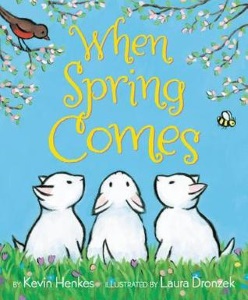2018 School Spending Survey Report
Five questions for Laura Dronzek
Laura Dronzek’s color-drenched illustrations for When Spring Comes (Greenwillow, 2–4 years) bring husband Kevin Henkes’s poetic text into full bloom.
 Photo: Kevin Henkes
Photo: Kevin HenkesLaura Dronzek’s color-drenched illustrations for When Spring Comes (Greenwillow, 2–4 years) bring husband Kevin Henkes’s poetic text into full bloom. Looking at her lively renderings of rain-soaked earth, flowering trees, baby animals, and other springtime delights, it’s easy to see Dronzek’s fine-arts background; her saturated acrylic paintings feature many similar subjects. In fact, her paintings of birds served as inspiration for the text of a previous picture book collaboration with Henkes, Birds (Greenwillow, 2–4 years), which Dronzek also illustrated.
1. What was the genesis of this current collaboration?
LD: I had finished the illustrations for It Is Night (by Phyllis Rowand; Greenwillow, 2–4 years) and was waiting for another project. When Kevin wrote When Spring Comes I loved the text, but thought he would illustrate it. On our wedding anniversary I opened a present that turned out to be the text for When Spring Comes. I was thrilled! Kevin had read it to Virginia Duncan, our editor, and she said she would love for me to illustrate it. It was the best anniversary present!
2. The sky is almost a character in your illustrations, with its moods as varied as its colors; it seems to be a major presence in your fine-art paintings, too. What is it about the sky that speaks to you?
LD: When I include the sky in my illustrations, I'm always thinking about the text and how I can best enhance or complement it. In my fine-art paintings the sky often conveys mood or emotion, which I guess is also true of my illustrations. I'm attracted to the way the sky is a constant presence but is always changing.
 3. What attracts you to working in acrylics, in both your picture books and your fine art?
3. What attracts you to working in acrylics, in both your picture books and your fine art?LD: I do work mainly in acrylics, although I started out using oils. I like the way acrylics can be layered over and over to create texture and subtle color. I also like that they dry quickly. When our children were young, I often had only short chunks of time to work, so it was great to be able to go back to work for two hours if there was a chance. I also like the direct nature of painting on paper or canvas. The viewer can see the artist's hand in the work. It seems a bit old-fashioned these days, with so many people doing art on the computer, but I can't imagine working any other way.
4. This book begins with a very familiar childhood experience: waiting. "If you wait, an egg will become a bird. A seed will start growing." We love your time-lapse depictions of these events and wonder what your relationship to waiting is. Do you have the patience for it or are you frustrated by it?
LD: My relationship to waiting has changed as I have grown older. I think many of us have a difficult time waiting when we are young. One is always waiting for the next thing to happen. Now I'm usually (but not always) pretty patient and try to enjoy the moment, because I feel as if everything comes faster and faster already and whatever I'm waiting for will get here fast enough!
5. Are those white kittens related to the kitten in Kitten's First Full Moon? Litter-mates? Cousins? Offspring?
LD: I wasn't consciously thinking of the kittens as being related to Kitten. It was an artistic choice, but maybe subconsciously...
From the March 2016 issue of Notes from the Horn Book.
RECOMMENDED
ALREADY A SUBSCRIBER? LOG IN
We are currently offering this content for free. Sign up now to activate your personal profile, where you can save articles for future viewing.







Add Comment :-
Comment Policy:
Comment should not be empty !!!
starr kopper
I 'm charmed by Laura's answers to the five questions. I too love to paint the changing expressions of the weather! You need to be quick to catch the fleeting sensation of sky and clouds. The feeling of brush and paint on a surface comes from direct observation and what one of my teachers called "the thunderclap of the moment."Posted : Mar 10, 2016 02:22